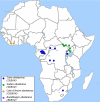Current ebola vaccines
- PMID: 22559078
- PMCID: PMC3422127
- DOI: 10.1517/14712598.2012.685152
Current ebola vaccines
Abstract
Introduction: Ebolaviruses cause severe viral hemorrhagic fever in humans and non-human primates (NHPs), with case fatality rates of up to 90%. Currently, neither a specific treatment nor a vaccine licensed for use in humans is available. However, a number of vaccine candidates have been developed in the last decade that are highly protective in NHPs, the gold standard animal model for ebola hemorrhagic fever.
Areas covered: This review analyzes a number of scenarios for the use of ebolavirus vaccines, discusses the requirements for ebolavirus vaccines in these scenarios and describes current ebolavirus vaccines. Among these vaccines are recombinant adenoviruses, recombinant vesicular stomatitis viruses (VSVs), recombinant human parainfluenza viruses and virus-like particles. Interestingly, one of these vaccine platforms, based on recombinant VSVs, has also demonstrated post-exposure protection in NHPs.
Expert opinion: The most pressing remaining challenge is now to move these vaccine candidates forward into human trials and toward licensure. In order to achieve this, it will be necessary to establish the mechanisms and correlates of protection for these vaccines, and to continue to demonstrate their safety, particularly in potentially immunocompromised populations. However, already now there is sufficient evidence that, from a scientific perspective, a vaccine protective against ebolaviruses is possible.
Figures


Similar articles
-
Ebolavirus Vaccines: Progress in the Fight Against Ebola Virus Disease.Cell Physiol Biochem. 2015;37(5):1641-58. doi: 10.1159/000438531. Epub 2015 Nov 5. Cell Physiol Biochem. 2015. PMID: 26535889 Review.
-
Antibody-Mediated Protective Mechanisms Induced by a Trivalent Parainfluenza Virus-Vectored Ebolavirus Vaccine.J Virol. 2019 Feb 5;93(4):e01845-18. doi: 10.1128/JVI.01845-18. Print 2019 Feb 15. J Virol. 2019. PMID: 30518655 Free PMC article.
-
Vesicular stomatitis virus-based vaccines protect nonhuman primates against Bundibugyo ebolavirus.PLoS Negl Trop Dis. 2013 Dec 19;7(12):e2600. doi: 10.1371/journal.pntd.0002600. eCollection 2013. PLoS Negl Trop Dis. 2013. PMID: 24367715 Free PMC article.
-
From bench to almost bedside: the long road to a licensed Ebola virus vaccine.Expert Opin Biol Ther. 2018 Feb;18(2):159-173. doi: 10.1080/14712598.2018.1404572. Epub 2017 Nov 17. Expert Opin Biol Ther. 2018. PMID: 29148858 Free PMC article. Review.
-
Distinct Immunogenicity and Efficacy of Poxvirus-Based Vaccine Candidates against Ebola Virus Expressing GP and VP40 Proteins.J Virol. 2018 May 14;92(11):e00363-18. doi: 10.1128/JVI.00363-18. Print 2018 Jun 1. J Virol. 2018. PMID: 29514907 Free PMC article.
Cited by
-
Immune memory to Sudan virus: comparison between two separate disease outbreaks.Viruses. 2015 Jan 6;7(1):37-51. doi: 10.3390/v7010037. Viruses. 2015. PMID: 25569078 Free PMC article.
-
Recent Advances in Therapeutic Approaches Against Ebola Virus Infection.Recent Adv Antiinfect Drug Discov. 2024;19(4):276-299. doi: 10.2174/0127724344267452231206061944. Recent Adv Antiinfect Drug Discov. 2024. PMID: 38279760 Review.
-
Assembly of Ebola virus matrix protein VP40 is regulated by latch-like properties of N and C terminal tails.PLoS One. 2012;7(7):e39978. doi: 10.1371/journal.pone.0039978. Epub 2012 Jul 5. PLoS One. 2012. PMID: 22792204 Free PMC article.
-
Vesicular Stomatitis Virus Pseudotyped with Ebola Virus Glycoprotein Serves as a Protective, Noninfectious Vaccine against Ebola Virus Challenge in Mice.J Virol. 2017 Aug 10;91(17):e00479-17. doi: 10.1128/JVI.00479-17. Print 2017 Sep 1. J Virol. 2017. PMID: 28615211 Free PMC article.
-
Progress of vaccine and drug development for Ebola preparedness.Clin Exp Vaccine Res. 2015 Jan;4(1):11-6. doi: 10.7774/cevr.2015.4.1.11. Epub 2015 Jan 30. Clin Exp Vaccine Res. 2015. PMID: 25648233 Free PMC article. Review.
References
-
- Sanchez A, Geisbert TW, Feldmann H. Filoviridae: Marburg and Ebola Viruses. In: Fields BN, Knipe DM, Howley PM, editors. Fields virology. 5th ed. Lippincott Williams & Wilkins; Philadelphia: 2007. pp. 1410–48.
-
- WHO WHO experts consultation on Ebola Reston pathogenicity in humans. 2009.
-
- Barrette RW, Metwally SA, Rowland JM, Xu L, Zaki SR, Nichol ST, et al. Discovery of swine as a host for the Reston ebolavirus. Science. 2009 Jul 10;325(5937):204–6. - PubMed
Publication types
MeSH terms
Substances
Grants and funding
LinkOut - more resources
Full Text Sources
Other Literature Sources
Medical
